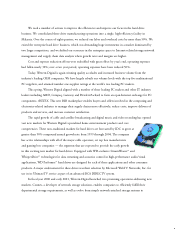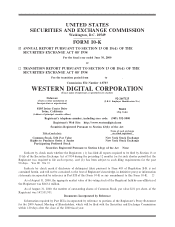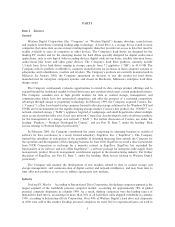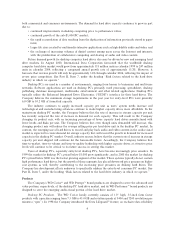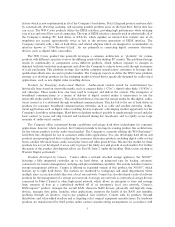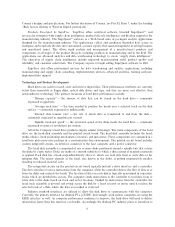Western Digital 2000 Annual Report Download - page 13
Download and view the complete annual report
Please find page 13 of the 2000 Western Digital annual report below. You can navigate through the pages in the report by either clicking on the pages listed below, or by using the keyword search tool below to find specific information within the annual report.desktop PC market. As a result, maintaining customer satisfaction with these leading computer manufacturers
has become even more critical.
Computer manufacturers typically seek to qualify up to three or four providers for each generation of hard
drives. Once a computer manufacturer has chosen its qualiÑed hard drive vendors for a given product, it
generally will purchase hard drives from those vendors for the life of that product. To achieve consistent
success with computer manufacturers' qualiÑcations, a hard drive supplier must be an early provider of next
generation hard drives featuring leading technology and high capacity per disk. Suppliers must quickly achieve
volume production of high quality and reliable hard drives. To quickly achieve high volume production, a hard
drive supplier must have access to Öexible, high-capacity, high-quality manufacturing capabilities. Factors on
which computer manufacturers evaluate their hard drive suppliers include overall quality, storage capacities,
performance characteristics, price, ease of doing business, and the supplier's long-term Ñnancial stability.
The business models of computer manufacturers are in the process of changing, and these changes have
impacted and will continue to impact Western Digital's sales, inventory and distribution patterns. The
forecast-driven, long-production-run logistics model, which most of the computer industry has used, exposes
manufacturers and others in the distribution chain to the risk of carrying excess or obsolete inventories. The
historical model limits the computer manufacturers' Öexibility to react to rapid technology changes and
component pricing Öuctuations. In response, the leading manufacturers require their hard drive suppliers to
maintain a small base stock of Ñnished product in locations adjacent to the customers' manufacturing
facilities. In addition, some of the Company's customers have implemented a supply chain logistics model that
combines ""build-to-order'' (computer manufacturer does not build until there is an order backlog) and
""contract manufacturing'' (computer manufacturer contracts assembly work to a contract manufacturer who
purchases components and assembles the computer based on the computer manufacturer's instructions.) The
Company then ships hard drives directly to the assembler for installation at its location. The Company has
adapted its logistics model to eÅectively align with these industry shifts. These changes require greater skill in
managing Ñnished goods inventory and more Öexibility in manufacturing, both of which in turn require even
closer relationships between the Company and its computer manufacturer and contract manufacturer
customers. To meet these challenges the Company is expanding its use of Internet technology and web-based
supply chain planning tools. In June 2000, the Company invested as a founder in a start-up company, eHitex,
Inc., formed by major suppliers and purchasers of components for personal computer manufacturing to
operate an Internet marketplace for such components. For an additional discussion of the changes in customer
models, refer to Part II, Item 7, under the headings ""Risk factors related to Western Digital particularly,'' and
""Risk factors related to the hard drive industry in which we operate.''
The Company maintains a base stock of two to three weeks of current, Ñnished goods inventory for
certain key computer manufacturer customers in facilities located adjacent to their operations. Inventory at
these locations usually includes minor product customizations (such as labeling) for the related computer
manufacturer. If subsequent to its initial order the computer manufacturer changes its requirements, inventory
held at these facilities can be sold to other computer manufacturers or distributors as is or with minor
modiÑcations (such as a change in labeling) at little or no additional cost. Therefore, these arrangements, even
if not fulÑlled, have minimal impact on inventory valuation.
Distributors. The Company uses a select group of distributors to sell its products to small computer
manufacturers, value-added resellers, resellers and systems integrators. The Company's major distributor
customers include ASI, CHS, Decision Support Systems, ELD, Ingram Micro, Merisel, Servex, Synnex and
Tech Data. Distributors and retailers combined accounted for approximately 31%, 30%, and 35% of disk drive
revenue for 1998, 1999, and 2000, respectively. Distributors generally enter into non-exclusive agreements
with the Company for purchase and redistribution of product on a quick turnover basis. Purchase orders are
placed and revised on a weekly basis.
Retailers. The Company sells its retail-packaged products directly to a select group of major retailers
such as computer superstores, warehouse clubs and computer electronics stores and authorizes sales through
distributors to smaller retailers. Major retailers to whom the Company sells directly include Best Buy,
Carrefour, Circuit City, CompUSA, Dixons, OÇce Depot and Vobis. Retailers accounted for approximately
8



